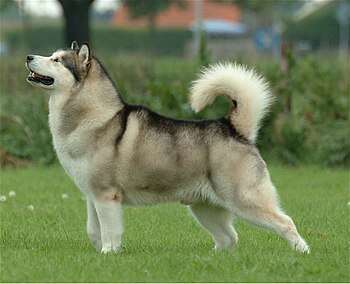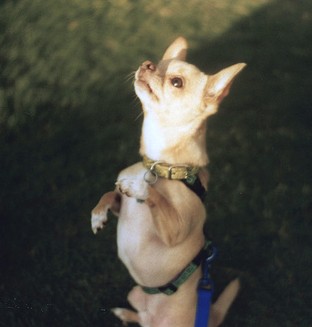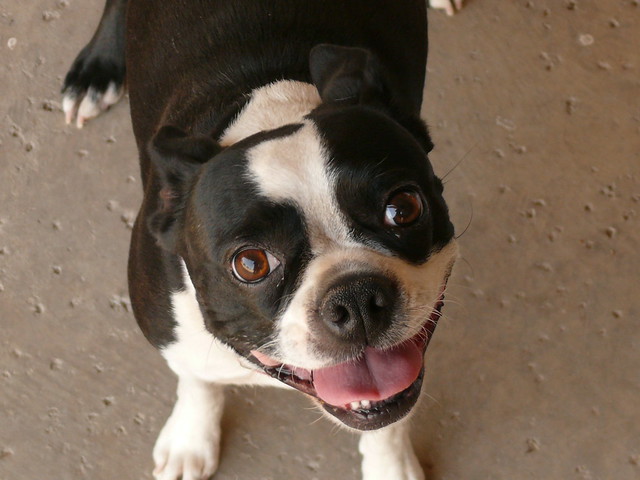So you have decided to get a sled dog. Not particularly for pulling a sled but that style of dog... but what type exactly? And when we are speaking of huskies the argument typically ends up being a final choice between Malamute vs Husky. Both are outstanding animals although there are subtle differences between both. Understanding these subtleties goes a very long way towards making sure you, your family and your dog make the very best match!
Lets uncover some more about the Husky vs Malamute...
 |
| Black and White Siberian Husky (Photo credit: Wikipedia) |
Malamute vs Husky - Origins
To most of us, the Siberian Husky and the Alaskan Malamute are very similar dogs. And in many ways they are. However in other ways, these two fine animals couldn't be more different!
Both the malamute and the husky are Nordic breeds and companion animals to their tribes families. These majestic animals were also bred, trained and developed to pull sleds for their tribes.
The Siberian Husky hails from Siberian tribe the Chukchi. The Malamute stems from the tribe name of the Mahlemuit Eskimos in Alaska and is believed to be descended from the Arctic Wolf. Both animals have been developed for centuries.
Malamute vs Husky - Coats and Markings
Both these dogs exist in a variety of facial markings and coat colors. Interestingly, both breeds have shades of gray, silver, red and tan mixed with white however the only solid color is white. The malamute and the Siberian husky (also called a Sibe) have an amazing variety of facial markings to distinguish them. It is not uncommon for these facial markings to create "masks" and even "goggles" which not only gives them their own unique individuality but also creates some mischievous looks at the same time!
 |
| Alaskan Malamute (Photo credit: Wikipedia) |
Malamute vs Husky - Eyes
One of the most spectacular features of both the Siberian Husky and the Alaskan Malamute is their eyes. Both are dazzling but both are unique. While the eyes of the Malamute are usually almond shaped and brown, there are no color restrictions for a Sibe.
Siberian Huskies are known for their striking sky blue eyes but may also have green or brown eyes. Cooler still is the fact that a Sibe can be bi-eyed (different colored eyes) or even parti-eyed (different colors in the same eye.).
Malamute vs Husky - Size and Grooming.
This is where the main differences between these two breeds are found. The largest of the Northern breeds, the Alaskan Malamute weighs up to 95 pounds and can usually stand anywhere from 24 to 26 inches tall.
With an average coat length of 3 inches, the malamute will shed quite a lot and needs a good brushing at least every two weeks. Weekly is better. Evolved to easily track through the snow, they have large, wide and round paws, almost in the shape of a snow shoe!
Although still a fair size, the Siberian Husky is classed more as a medium sized breed. Standing at around 20 to 23 inches and weighing in anywhere between 45 to 60 pounds.
Grooming is the big difference between these breeds! Much like a cat, the Siberian Husky is a very clean animal and will bathe and lick itself almost relentlessly. This pooch really looks after itself and a good thorough brushing two or three times a year will be all you need!
The Sibe also changes it's coat with the climate to get ready for the next season.
Regarding the sizing of these animals, the details listed above are actual "show standards." Malamutes and Huskies bred as pets can often be a few inches taller and a few pounds heavier.
Malamute vs Husky - Temperaments.
The temperaments of both breeds are very similar. Considering that they are working dogs they need a lot of exercise and lots of room to move. Got an apartment or small yard? Then this is not the sort of dog for you.
The malamute and the husky are also tremendously loyal pack animals. They crave to give and of course receive love and attention. Social animals that they are, being alone is not a good match. Boredom and loneliness can trigger damage and destruction.
Malamute vs Husky - Final Say.
All things considered, both breeds are outstanding animals with many similarities. Both dogs require attention and love and loads of room to move and exercise. Both breeds have wonderful personalities and both will most likely steal your heart!
In the end, if you prefer a large playful pooch and have time for grooming then the Alaskan Malamute is ideal. Nevertheless, if you are considering a slightly smaller dog with less coat maintenance then the Siberian Husky is the breed for you.
The Husky is my absolute favorite breed of dog! Loyal, affectionate, exciting and just loves to run and have fun!
Article Source: EzineArticles |

















